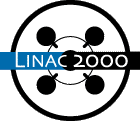
J. F. TOOKER, B. BOURQUE, D. CHRISTIANSEN, J. KAMPERSCHROER, G. LAUGHON, M. MCCARTHY, M. SCHULSE (General Atomics)
The accelerator for the APT is a 100 mA CW proton linac with an energy of 1030 MeV. A High Energy Beam Transport (HEBT) conveys the beam to a raster expander, that produces a large rectangular distribution at a target/blanket assembly, where spallation neutrons generated by the proton beam are absorbed in Helium-3 to produce tritium. The design of the APT linac is an integrated normal-conducting (NC)/superconducting (SC) proton linac. The NC linac consists of a 75 keV injector, a 6.7-MeV 350-MHz Radio Frequency Quadrupole, a 96-MeV 700-MHz Coupled-Cavity Drift-Tube Linac, and a 700-MHz Coupled-Cavity Linac, with an output energy of 211 MeV. This is followed by a SC linac, that employs 700-MHz elliptical niobium 5-cell cavities to accelerate the beam to the final energy. The cavities are optimized for beam velocities of beta of 0.64 and 0.82, and are grouped in cryomodules containing two, three, or four cavities, driven by 1-MW 700-MHz klystrons. The singlet FODO lattice in the NC linac transitions to a doublet focusing lattice in the SC linac, with conventional quadrupole magnets in the warm inter-module spaces. This doublet lattice is continued in the HEBT. An overview of the current linac design will be presented.
* Work supported by DOE contract: DE-AC04-96AL89607
Comments or Questions to
linac2000@slac.stanford.edu